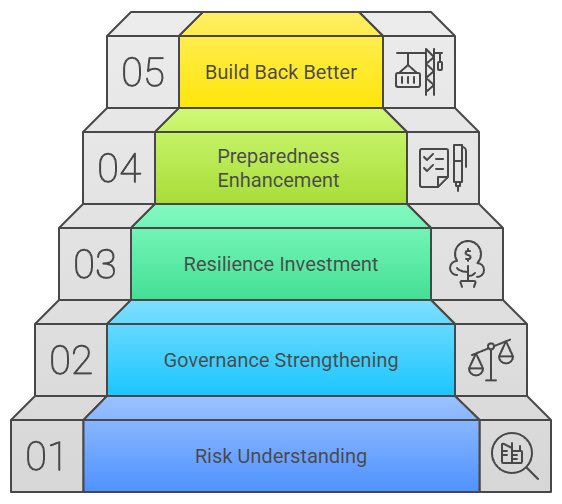
Sendai Framework of Action
This section provides a framework for understanding the Post 2015 Development Agendas.
When the Millennium Development Goals (MDGs) ended in 2015, the international community came together once again, under the auspices of the United Nations, to formulate a development agenda for adoption beyond 2015.
These six agendas (which go beyond just the SDGs) together became known as the "Post-2015 Agendas"
The Sendai Framework shifts focus from reacting to disasters to proactively managing risks and building resilient communities. It stresses investing in preparedness, early warning systems, and recovery strategies that strengthen future resilience and protect development gains.

Main Thematic Areas:
- Risk understanding
- Strengthening disaster risk governance
- Investing in resilience
- Enhancing disaster preparedness
- Building back better during recovery
The Sendai Framework promotes a shift from disaster response to risk management and resilience building. Its key thematic areas include understanding disaster risk, strengthening disaster risk governance, investing in disaster risk reduction for resilience, and enhancing preparedness for effective response and recovery. It emphasizes "building back better" in recovery, rehabilitation, and reconstruction processes, recognizing that reducing disaster risk is essential for achieving sustainable development.

Facts and Figures:
- Natural disasters affected over 300 million people annually between 2005 and 2015 (UNDRR).
- Only 47 countries reported having national DRR strategies aligned with Sendai by 2022 (UNDRR).
- Economic losses from disasters between 2005 and 2015 were estimated at $1.4 trillion globally.
- Urban populations at risk from cyclones and earthquakes are expected to double by 2050.
- The Sendai Framework targets a substantial reduction in global disaster mortality by 2030.
- Sendai Framework for Disaster Risk Reduction 2015-2030: This global blueprint outlines priorities for reducing disaster risks and losses in lives, livelihoods, and health and strengthens disaster preparedness and resilience.
- Global Platform for Disaster Risk Reduction: A biennial forum organized by UNDRR to assess global and regional implementation of the Sendai Framework, exchange good practices, and build partnerships.
- National Disaster Risk Reduction Strategies: Countries are encouraged to develop and implement national and local disaster risk reduction strategies aligned with the Sendai Framework's goals and targets.
- Sendai Framework for Disaster Risk Reduction 2015-2030
- Global Platform for Disaster Risk Reduction
- Disaster Risk Reduction Terminology
Case Studies
| Plan International (Asia and Africa): Plan International runs disaster risk reduction (DRR) education programs in schools, teaching children how to prepare for and respond to natural hazards in disaster-prone regions. | The Global Network of Civil Society Organisations for Disaster Reduction (GNDR) (Global): GNDR conducts community-led risk mapping and advocates for more local voices in national disaster risk policies aligned with the Sendai Framework. | Practical Action (South Asia and Africa): Practical Action develops low-cost, community-based early warning systems for floods and cyclones, integrating traditional knowledge with modern technology. |
| C ommunity-Based Flood Early Warning System (Nepal): Practical early warning tools developed with local communities along river basins reduce flood risks and improve preparedness. | Japanese School Safety Program (Japan): Integrating earthquake drills and risk education in school curricula strengthens community-wide resilience and aligns with Sendai principles. | RIMES (Asia-Pacific): The Regional Integrated Multi-Hazard Early Warning System enhances regional collaboration for early warning and risk analysis across Southeast and South Asia. |
GDRC Research Output |
|